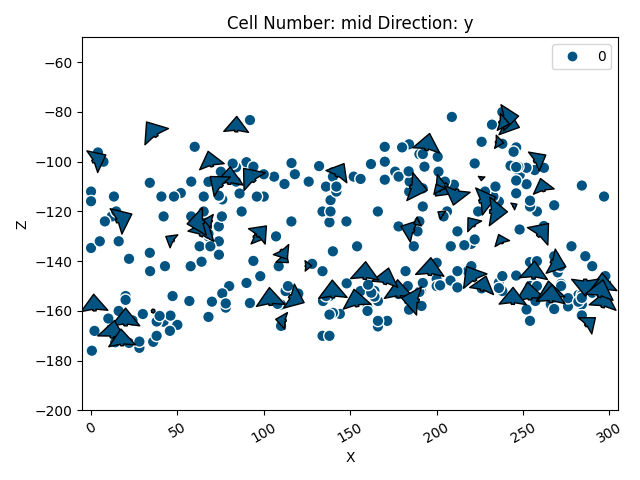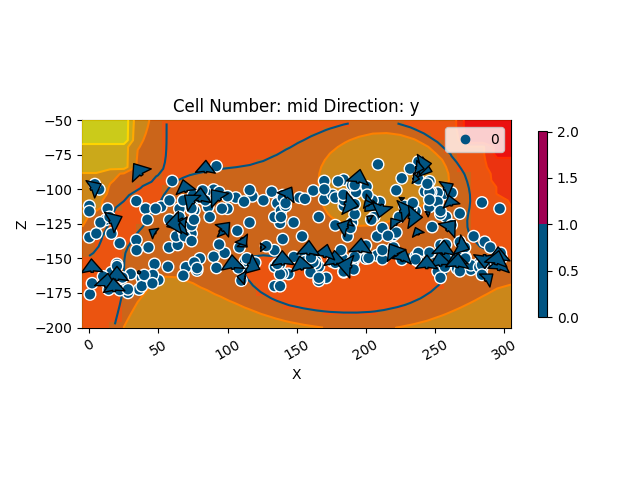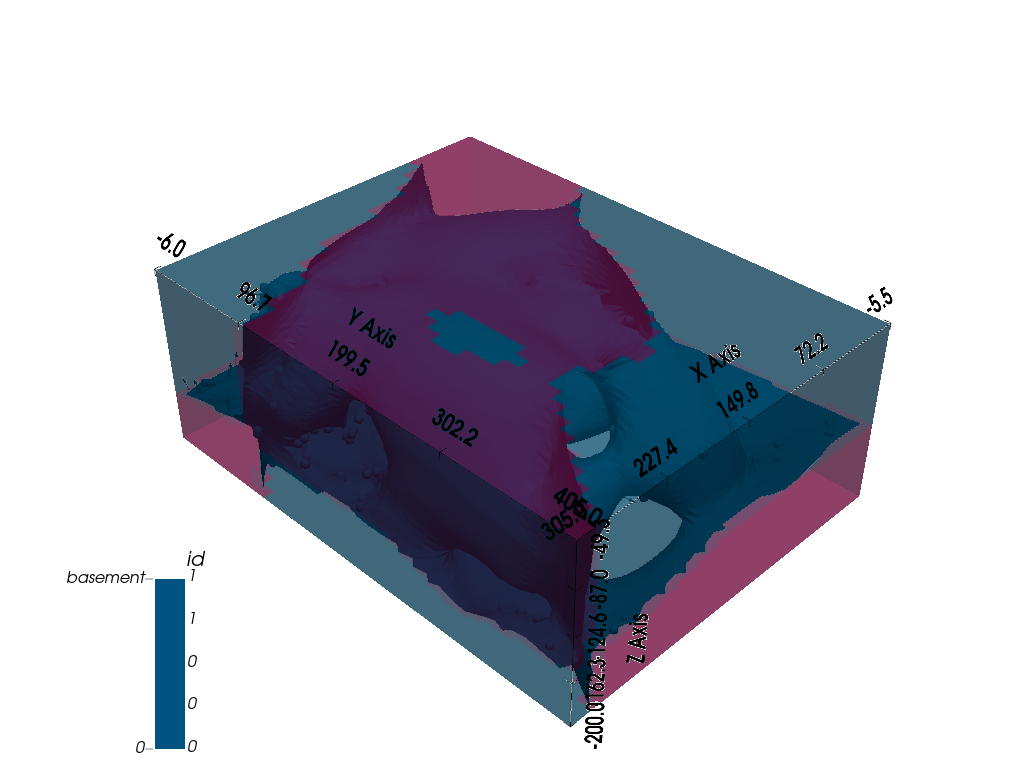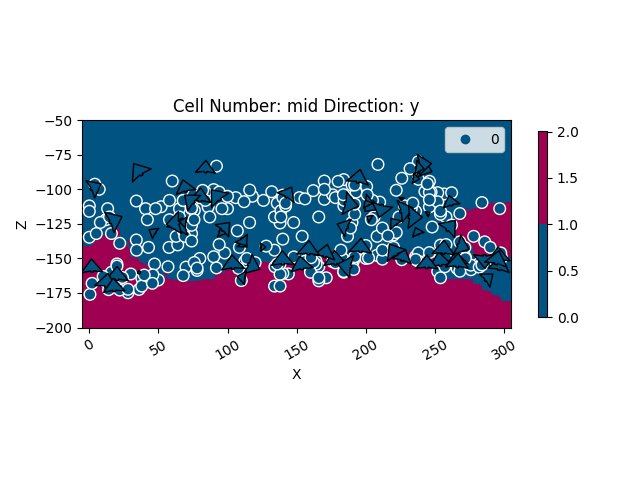Note
Go to the end to download the full example code.
Geomodeling benchmark: the “Moureze”-Model¶
This model is part of a geomodeling benchmaring effort. More information (and, hopefully, publication) coming.
import os
These two lines are necessary only if gempy is not installed
# Importing gempy
import gempy as gp
import gempy_viewer as gpv
# Aux imports
import numpy as np
import pandas as pd
from gempy_engine.config import AvailableBackends
Loading surface points from repository:¶
With pandas we can do it directly from the web and with the right args we can directly tidy the data in gempy style:
data_path = os.path.abspath('../../data/input_data/Moureze')
Moureze_points = pd.read_csv(
filepath_or_buffer=data_path + '/Moureze_Points.csv',
sep=';',
names=['X', 'Y', 'Z', 'G_x', 'G_y', 'G_z', '_'],
header=0,
)
Sections_EW = pd.read_csv(
filepath_or_buffer=data_path + '/Sections_EW.csv',
sep=';',
names=['X', 'Y', 'Z', 'ID', '_'], header=1
).dropna()
Sections_NS = pd.read_csv(
filepath_or_buffer=data_path + '/Sections_NS.csv',
sep=';',
names=['X', 'Y', 'Z', 'ID', '_'], header=1
).dropna()
Extracting the orientatins:
mask_surfpoints = Moureze_points['G_x'] < -9999
surface_points = Moureze_points[mask_surfpoints][::10]
orientations = Moureze_points[~mask_surfpoints][::10]
Giving an arbitrary value name to the surface
surface_points['surface'] = '0'
orientations['surface'] = '0'
surface_points.tail()
orientations.tail()
Data initialization:¶
Suggested size of the axis-aligned modeling box:
Origin: -5 -5 -200
Maximum: 305 405 -50
Suggested resolution: 2m (grid size 156 x 206 x 76)
Only using one orientation because otherwhise it gets a mess¶
Number voxels
np.array([156, 206, 76]).prod()
np.int64(2442336)
resolution_requ = [156, 206, 76]
resolution = [77, 103, 38]
resolution_low = [45, 51, 38]
surface_points_table: gp.data.SurfacePointsTable = gp.data.SurfacePointsTable.from_arrays(
x=surface_points['X'].values,
y=surface_points['Y'].values,
z=surface_points['Z'].values,
names=surface_points['surface'].values.astype(str)
)
orientations_table: gp.data.OrientationsTable = gp.data.OrientationsTable.from_arrays(
x=orientations['X'].values,
y=orientations['Y'].values,
z=orientations['Z'].values,
G_x=orientations['G_x'].values,
G_y=orientations['G_y'].values,
G_z=orientations['G_z'].values,
names=orientations['surface'].values.astype(str),
name_id_map=surface_points_table.name_id_map # ! Make sure that ids and names are shared
)
structural_frame: gp.data.StructuralFrame = gp.data.StructuralFrame.from_data_tables(
surface_points=surface_points_table,
orientations=orientations_table
)
geo_model: gp.data.GeoModel = gp.create_geomodel(
project_name='Moureze',
extent=[-5, 305, -5, 405, -200, -50],
# resolution=resolution_low,
refinement=5,
structural_frame=structural_frame
)
Now we can see how the data looks so far:
gpv.plot_2d(geo_model, direction='y')

<gempy_viewer.modules.plot_2d.visualization_2d.Plot2D object at 0x7fbc9ec7a3e0>
The default range is always the diagonal of the extent. Since in this model data is very close we will need to reduce the range to 5-10% of that value:
gp.compute_model(
gempy_model=geo_model,
engine_config=gp.data.GemPyEngineConfig(
use_gpu=False,
dtype='float32',
backend=AvailableBackends.PYTORCH
)
)
Setting Backend To: AvailableBackends.PYTORCH
Number of voxels marked by stats: 437 of torch.Size([512]).
Number of voxels marked by corners : 408
Total voxels: 437
Dense Grid would be 512 voxels
Chunking done: 30 chunks
Number of voxels marked by stats: 3053 of torch.Size([3736]).
Number of voxels marked by corners : 1989
Total voxels: 3053
Dense Grid would be 4096 voxels
Chunking done: 25 chunks
Chunking done: 197 chunks
Chunking done: 35 chunks
Time¶
300k voxels 3.5k points¶
Nvidia 2080: 500 ms ± 1.3 ms per loop (mean ± std. dev. of 7 runs, 1 loop each), Memory 1 Gb
CPU 14.2 s ± 82.4 ms per loop (mean ± std. dev. of 7 runs, 1 loop each), Memory: 1.3 Gb
2.4 M voxels, 3.5k points¶
CPU 2min 33s ± 216 ms per loop (mean ± std. dev. of 7 runs, 1 loop each) Memory: 1.3 GB
Nvidia 2080: 1.92 s ± 6.74 ms per loop (mean ± std. dev. of 7 runs, 1 loop each) 1 Gb
2.4 M voxels, 3.5k points 3.5 k orientations¶
Nvidia 2080: 2.53 s ± 1.31 ms per loop (mean ± std. dev. of 7 runs, 1 loop each)
gpv.plot_2d(geo_model, cell_number='mid', series_n=0, show_scalar=True)

<gempy_viewer.modules.plot_2d.visualization_2d.Plot2D object at 0x7fbc9ec7aec0>
gpv.plot_2d(geo_model, cell_number='mid', show_data=True, direction='y')

<gempy_viewer.modules.plot_2d.visualization_2d.Plot2D object at 0x7fbcb5a16890>
sphinx_gallery_thumbnail_number = 4
gpv.plot_3d(geo_model)

<gempy_viewer.modules.plot_3d.vista.GemPyToVista object at 0x7fbc9ec7add0>
Total running time of the script: (0 minutes 10.680 seconds)


